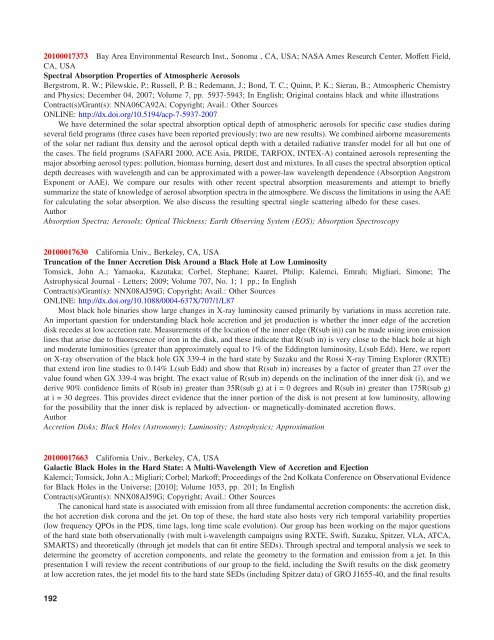NASA Scientific and Technical Aerospace Reports - The University ...
NASA Scientific and Technical Aerospace Reports - The University ...
NASA Scientific and Technical Aerospace Reports - The University ...
You also want an ePaper? Increase the reach of your titles
YUMPU automatically turns print PDFs into web optimized ePapers that Google loves.
20100017373 Bay Area Environmental Research Inst., Sonoma , CA, USA; <strong>NASA</strong> Ames Research Center, Moffett Field,<br />
CA, USA<br />
Spectral Absorption Properties of Atmospheric Aerosols<br />
Bergstrom, R. W.; Pilewskie, P.; Russell, P. B.; Redemann, J.; Bond, T. C.; Quinn, P. K.; Sierau, B.; Atmospheric Chemistry<br />
<strong>and</strong> Physics; December 04, 2007; Volume 7, pp. 5937-5943; In English; Original contains black <strong>and</strong> white illustrations<br />
Contract(s)/Grant(s): NNA06CA92A; Copyright; Avail.: Other Sources<br />
ONLINE: http://dx.doi.org/10.5194/acp-7-5937-2007<br />
We have determined the solar spectral absorption optical depth of atmospheric aerosols for specific case studies during<br />
several field programs (three cases have been reported previously; two are new results). We combined airborne measurements<br />
of the solar net radiant flux density <strong>and</strong> the aerosol optical depth with a detailed radiative transfer model for all but one of<br />
the cases. <strong>The</strong> field programs (SAFARI 2000, ACE Asia, PRIDE, TARFOX, INTEX-A) contained aerosols representing the<br />
major absorbing aerosol types: pollution, biomass burning, desert dust <strong>and</strong> mixtures. In all cases the spectral absorption optical<br />
depth decreases with wavelength <strong>and</strong> can be approximated with a power-law wavelength dependence (Absorption Angstrom<br />
Exponent or AAE). We compare our results with other recent spectral absorption measurements <strong>and</strong> attempt to briefly<br />
summarize the state of knowledge of aerosol absorption spectra in the atmosphere. We discuss the limitations in using the AAE<br />
for calculating the solar absorption. We also discuss the resulting spectral single scattering albedo for these cases.<br />
Author<br />
Absorption Spectra; Aerosols; Optical Thickness; Earth Observing System (EOS); Absorption Spectroscopy<br />
20100017630 California Univ., Berkeley, CA, USA<br />
Truncation of the Inner Accretion Disk Around a Black Hole at Low Luminosity<br />
Tomsick, John A.; Yamaoka, Kazutaka; Corbel, Stephane; Kaaret, Philip; Kalemci, Emrah; Migliari, Simone; <strong>The</strong><br />
Astrophysical Journal - Letters; 2009; Volume 707, No. 1; 1 pp.; In English<br />
Contract(s)/Grant(s): NNX08AJ59G; Copyright; Avail.: Other Sources<br />
ONLINE: http://dx.doi.org/10.1088/0004-637X/707/1/L87<br />
Most black hole binaries show large changes in X-ray luminosity caused primarily by variations in mass accretion rate.<br />
An important question for underst<strong>and</strong>ing black hole accretion <strong>and</strong> jet production is whether the inner edge of the accretion<br />
disk recedes at low accretion rate. Measurements of the location of the inner edge (R(sub in)) can be made using iron emission<br />
lines that arise due to fluorescence of iron in the disk, <strong>and</strong> these indicate that R(sub in) is very close to the black hole at high<br />
<strong>and</strong> moderate luminosities (greater than approximately equal to 1% of the Eddington luminosity, L(sub Edd). Here, we report<br />
on X-ray observation of the black hole GX 339-4 in the hard state by Suzaku <strong>and</strong> the Rossi X-ray Timing Explorer (RXTE)<br />
that extend iron line studies to 0.14% L(sub Edd) <strong>and</strong> show that R(sub in) increases by a factor of greater than 27 over the<br />
value found when GX 339-4 was bright. <strong>The</strong> exact value of R(sub in) depends on the inclination of the inner disk (i), <strong>and</strong> we<br />
derive 90% confidence limits of R(sub in) greater than 35R(sub g) at i=0degrees <strong>and</strong> R(sub in) greater than 175R(sub g)<br />
ati=30degrees. This provides direct evidence that the inner portion of the disk is not present at low luminosity, allowing<br />
for the possibility that the inner disk is replaced by advection- or magnetically-dominated accretion flows.<br />
Author<br />
Accretion Disks; Black Holes (Astronomy); Luminosity; Astrophysics; Approximation<br />
20100017663 California Univ., Berkeley, CA, USA<br />
Galactic Black Holes in the Hard State: A Multi-Wavelength View of Accretion <strong>and</strong> Ejection<br />
Kalemci; Tomsick, John A.; Migliari; Corbel; Markoff; Proceedings of the 2nd Kolkata Conference on Observational Evidence<br />
for Black Holes in the Universe; [2010]; Volume 1053, pp. 201; In English<br />
Contract(s)/Grant(s): NNX08AJ59G; Copyright; Avail.: Other Sources<br />
<strong>The</strong> canonical hard state is associated with emission from all three fundamental accretion components: the accretion disk,<br />
the hot accretion disk corona <strong>and</strong> the jet. On top of these, the hard state also hosts very rich temporal variability properties<br />
(low frequency QPOs in the PDS, time lags, long time scale evolution). Our group has been working on the major questions<br />
of the hard state both observationally (with mult i-wavelength campaigns using RXTE, Swift, Suzaku, Spitzer, VLA, ATCA,<br />
SMARTS) <strong>and</strong> theoretically (through jet models that can fit entire SEDs). Through spectral <strong>and</strong> temporal analysis we seek to<br />
determine the geometry of accretion components, <strong>and</strong> relate the geometry to the formation <strong>and</strong> emission from a jet. In this<br />
presentation I will review the recent contributions of our group to the field, including the Swift results on the disk geometry<br />
at low accretion rates, the jet model fits to the hard state SEDs (including Spitzer data) of GRO J1655-40, <strong>and</strong> the final results<br />
192

















